APAC Vacuum Pumps Market Size
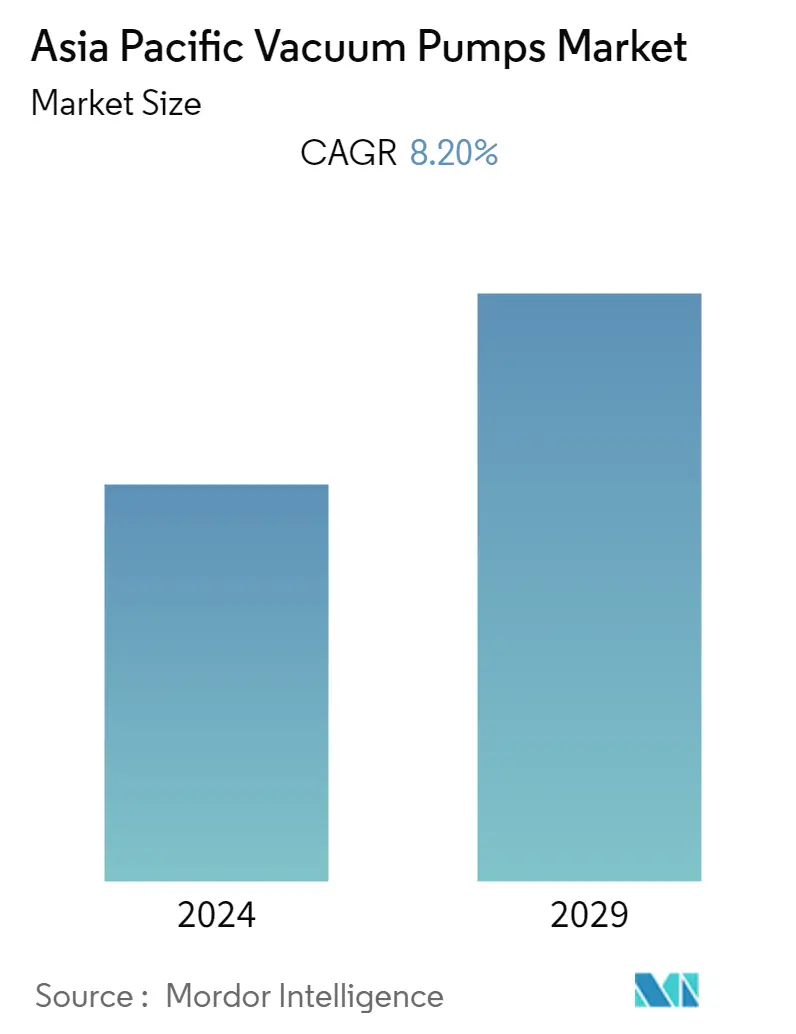
| Study Period | 2019 - 2029 |
| Base Year For Estimation | 2023 |
| Forecast Data Period | 2024 - 2029 |
| Historical Data Period | 2019 - 2022 |
| CAGR | 8.20 % |
| Market Concentration | Medium |
Major Players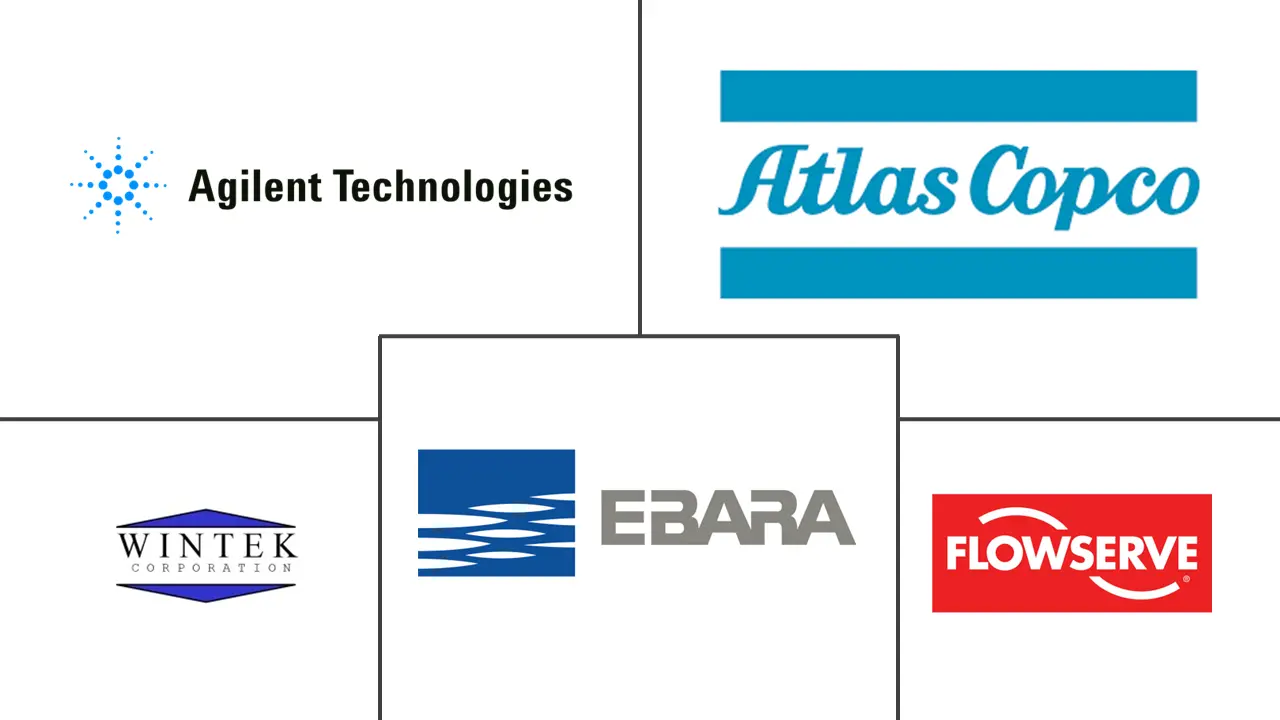
*Disclaimer: Major Players sorted in no particular order |
APAC Vacuum Pumps Market Analysis
The Asia Pacific Vacuum Pump market is expected to register a CAGR of 8.2% during the forecast period. In recent years, there has been a significant rise in the number of small-scale vacuum pump manufacturers opening up shops in developing nations as they collaborate with OEMs from other countries to produce inexpensive pumps for use in end-user sectors. Since vacuum pumps are already a standard component of production machinery in the majority of end-user verticals, there is a far bigger demand for retrofitting than for new installations.
- One of the major drivers of the market's expansion is the booming chemical industry. Vacuum pumps are also employed in the manufacture of cabinets, glass and stone cutting industries, flight instruments, electron microscopy, photolithography, uranium enrichment, and composite molding. Additionally, they work in the food and beverage (F&B) business to produce chocolate, process dairy, roast coffee, deaerate mineral water, and sterilize tea and spices. Vacuum pumps are also utilized in the pharmaceutical industry for drying, degassing, distillation, and crystallization. In addition, moisture and incondensable gases like air pollute air conditioning and refrigeration systems. Internal icing and corrosion can occur in these systems when one of these constituents, or both, are present.
- According to the Indian Brand Equity Foundation, Industrial licensing and 100% FDI, under the automatic method, are permitted in the chemical sector, with a few exceptions for dangerous substances. Between April 2000 and December 2021, foreign direct investment (FDI) inflows to the chemicals sector (excluding fertilizers) totaled USD19.09 billion.
- The expanding use of MEMS technology in the vacuum pump industry is anticipated to augment the market growth. MEMS technology offers a wide range of uses in several market segments, especially in consumer electronics such as smartphones, tablets, and video game consoles. For instance, since people's perception of their immediate environment has altered, MEMS-based environmental hubs and gas sensor vacuum pumps are becoming more common. Due to pollution, people are more concerned with the quality of the air they breathe both inside and outside of their homes.
- Due to supply chain and logistics disruptions brought on by the COVID-19 pandemic, the market for vacuum technologies was initially impacted. Later on, though, it saw a rise in the use of a number of additional methods. According to AltasCopco, the demand for vacuum equipment in the semiconductor industry has raised order volumes for equipment. Order intake rose in Asia but fell in North America. The industries have begun to resume their activities at pre-pandemic levels and above; therefore, the market is anticipated to continue growing.
- In August 2021, in the dry screw vacuum pump market, EDS set a new standard. Designed for the most challenging industrial and chemical installations. The EDS family is available in both air-cooled and water-cooled models and has pollutant management capabilities that are unmatched even in demanding chemical and industrial applications. The EDS line is the ideal choice for demanding industrial and chemical applications thanks to its simplicity, ease of maintenance, and high speed.
APAC Vacuum Pumps Market Trends
This section covers the major market trends shaping the APAC Vacuum Pumps Market according to our research experts:
The Oil and Gas Segment is Expected to Hold a Major Market Share
- According to BP PLC, the oil production in the Asia-Pacific region in the year 2021 was around 7,335 thousand barrels per day. Further, according to the Petroleum Planning & Analysis Cell, the volume of crude oil production in India in FY 2021 amounted to about 30.5 million metric tons. The high production of oil in the region will significantly create an opportunity for the local and international players to develop new products to cater to the needs of the customers.
- The firms are expanding their production capacity of gas so that they can cater to a wide range of needs of customers; this will significantly drive the demand of the studied market in the region. For instance, in August 2022, at the cost of INR 169.11 crore, Indian Oil Corporation (IOC) announced the opening of its newest greenfield LPG bottling facility in Agartala. The plant can bottle 17,000 cylinders daily, including home and commercial ones, and has a rated capacity of 60,000 thousand metric tons per annum (TMTPA). Additionally, it has a 1,350 MT capacity for leak-proof mounded LPG bullets.
- Further, in March 2022, after posting its strongest profit in a decade, China Petroleum & Chemical Corp, better known as Sinopec, is preparing to make its largest capital investment in history for 2022, repeating Beijing's urge for energy companies to increase production. It intends to invest CNY 81.5 billion in upstream exploitation, focusing on the natural gas fields in Sichuan province and the Inner Mongolia region, as well as the crude oil bases in the Shunbei and Tahe fields.
- Vacuum and compressor systems can handle saturated inlet gas streams, explosive gas mixtures, dirty, abrasive gas mixtures, and unpredictable streams that alter depending on the process variables. This results in safe, non-polluting gas and vapor management. Vapor recovery, which is used in the oil and gas sector, is the process of recovering hydrocarbon vapors from stock tanks during upstream production or downstream refining, where the vapors are typically discharged into the atmosphere. By creating a vacuum and compressing the vapors in the stock tanks, vapor recovery can be accomplished. Hexane vapors can be collected, liquefied, and then reused by employing liquid ring pumps. In this application or procedure, the condensable gases are separated using a separator, and the recovered gas is compressed.
- Over the past few years, the shale boom and changing oil and gas landscape have driven oil and gas production growth, much of which has been enabled by advancements in vacuum pumps. The modern shale production well pad design generally requires 8 to 24 wells, each of which could produce oil and natural gas. The economics of the contemporary oil and gas field involves a concentration of measurement controls in a single location.
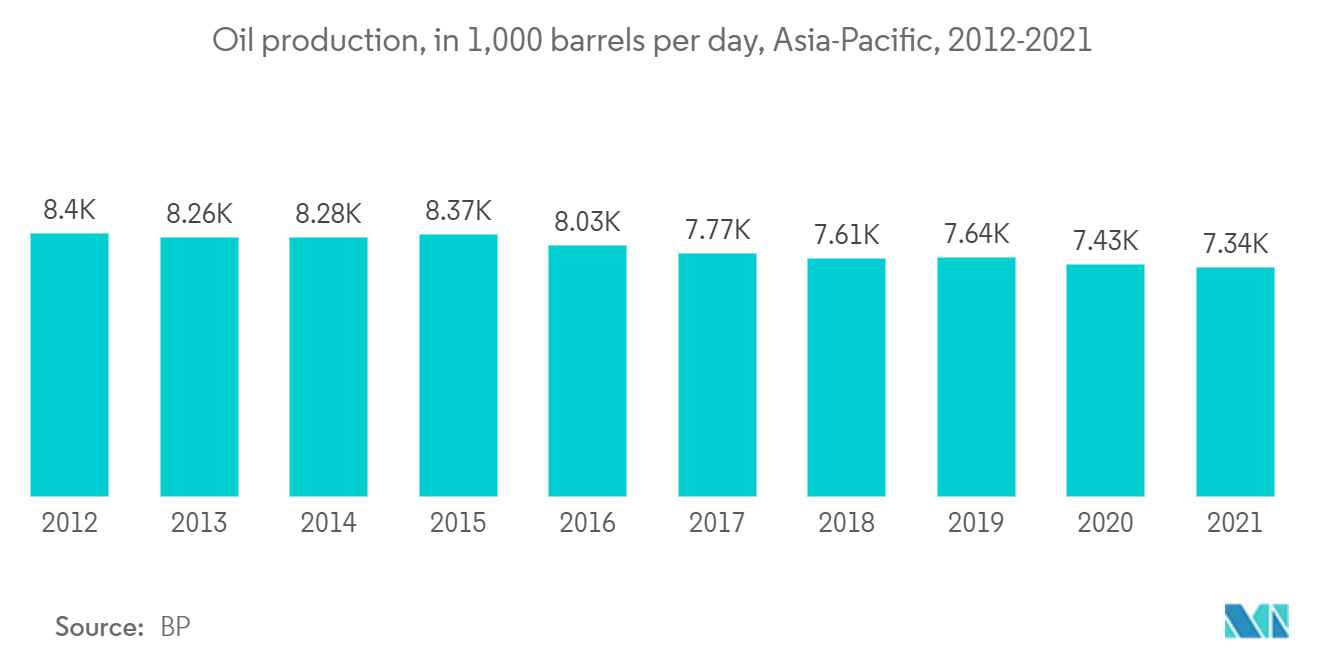
China is Expected to Witness a High Market Growth
- Vacuum pump product development is dependent on the growth of numerous industries, and as new industries have emerged, so have new needs. Different technical requirements for vacuum pumps have emerged in recent years in specific sectors like semiconductors, photovoltaics, new energy, optical optoelectronics, and other industries; this presents both an opportunity and a challenge for vacuum pump companies, those manufacturers who can meet the needs of market innovation, brands that can provide solutions for new industries, in order to obtain better development in the region.
- The R&D division of China HokaidoVacuum Pump Company has been putting a lot of effort into improving and innovating vacuum pump technology, structure, and application because it is the company's key product. The business has designated R&D funding for the growth of new market segments, the creation and marketing of new products, and the technical performance of existing items. The product research and development division of Hokaidoinsists in the research and development of vacuum pumps from two directions: the first is technology-oriented, and it relentlessly pursues high-end technology; the second is customer demand-oriented, and it pays close attention to the direction of industry development, while also paying close attention to the usual work, in-depth understanding of customer needs, and direction of industry development, according to which technology and products are created in accordance with the needs of customers and various industries.
- In order to provide a highly-controlled environment with zero dust, vacuum pumps are a must in the semiconductor sector. Solar panels, 4G and 5G network testing, as well as their widespread use have all contributed to the semiconductor and electronics industry's expansion.
- Additionally, the introduction of COVID-19 caused a spike in demand for central vacuum systems, which include vacuum pumps and provide suction during operations; this showed the use of vacuum pumps has increased in the medical and healthcare sector.
- The Food and Drug Administration states that as human pharmaceuticals and biologics are sensitive, they must be packaged in accordance with strict rules for container closure integrity testing. Vacuum pumps are therefore used to ensure the aseptic packaging of food and drink products. To prevent oxidation, the MAP method enables the removal of air, in particular oxygen. Vacuum pumps are needed because of the rising demand for packaged foods and beverages and the strict regulatory requirements imposed on food packaging. The food and beverage industry is propelling, which raises the need for vacuum pumps at the same time as the number of working professionals, particularly women, and the rate of urbanization is on the rise.
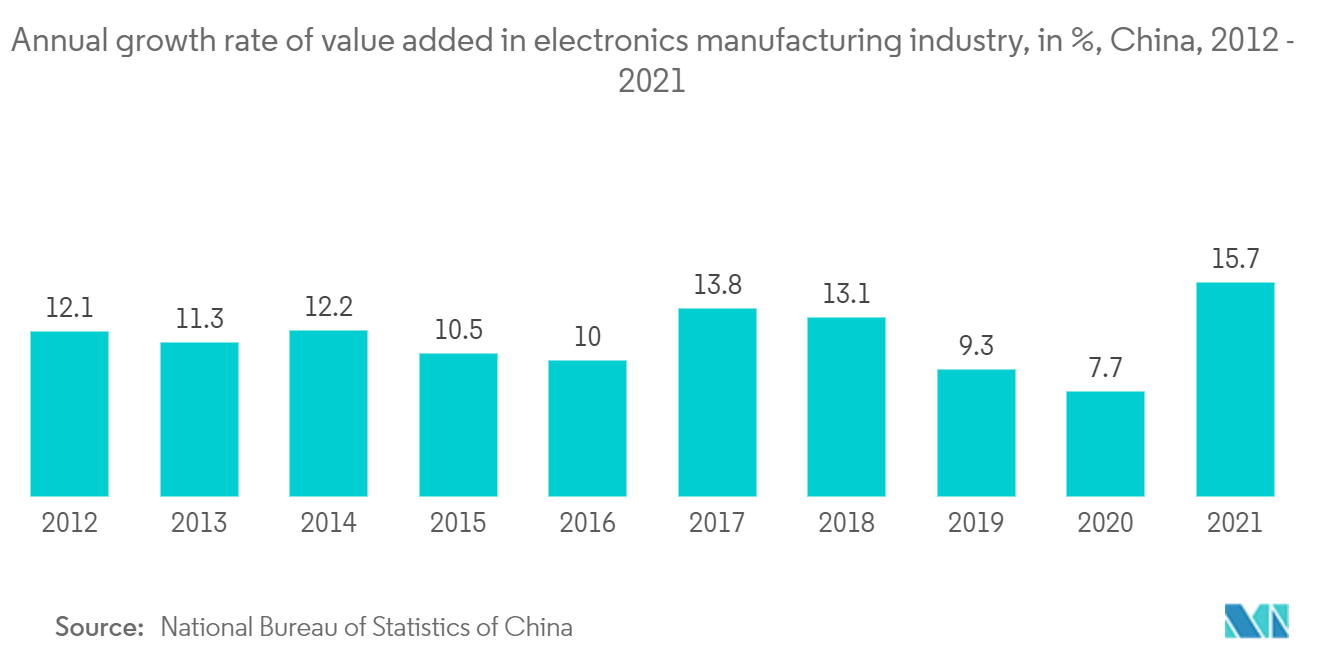
APAC Vacuum Pumps Industry Overview
The Asia Pacific vacuum pump market is moderately fragmented due to the presence of prominent global and local players. Also, global investment in R&D in power generation infrastructure and facility advancements in oil and gas are the essential drivers that are giving intense rivalry among competitors. Key players are Agilent Technologies Inc., Atlas Copco Group, Flowserve Corporation, etc.
- March 2022 - Gebr.Becker GmBHInternational, a global manufacturer of vacuum and pneumatic equipment, announced their launch of India operations by launching a wholly owned subsidiary - Gebr.BeckerIndia Vacuum Pumps Pvt. Ltd, headquartered in Pune. The objective behind launching Gebr.Becker GmBH'ssubsidiary in India was to maintain its established goodwill with customers.
- March 2022 - Through its specialist vacuum brand, Elmo Rietschle, Ingersoll Rand launched a new SVT Series of high-efficiency, high-capacity oil-lubricated rotary screw vacuum pumps designed for industries like electronics and food & beverage.
APAC Vacuum Pumps Market Leaders
-
Agilent Technologies Inc.
-
Atlas copco
-
Wintek Corporation
-
Ebara Corporation
-
Flowserve Corporation
*Disclaimer: Major Players sorted in no particular order
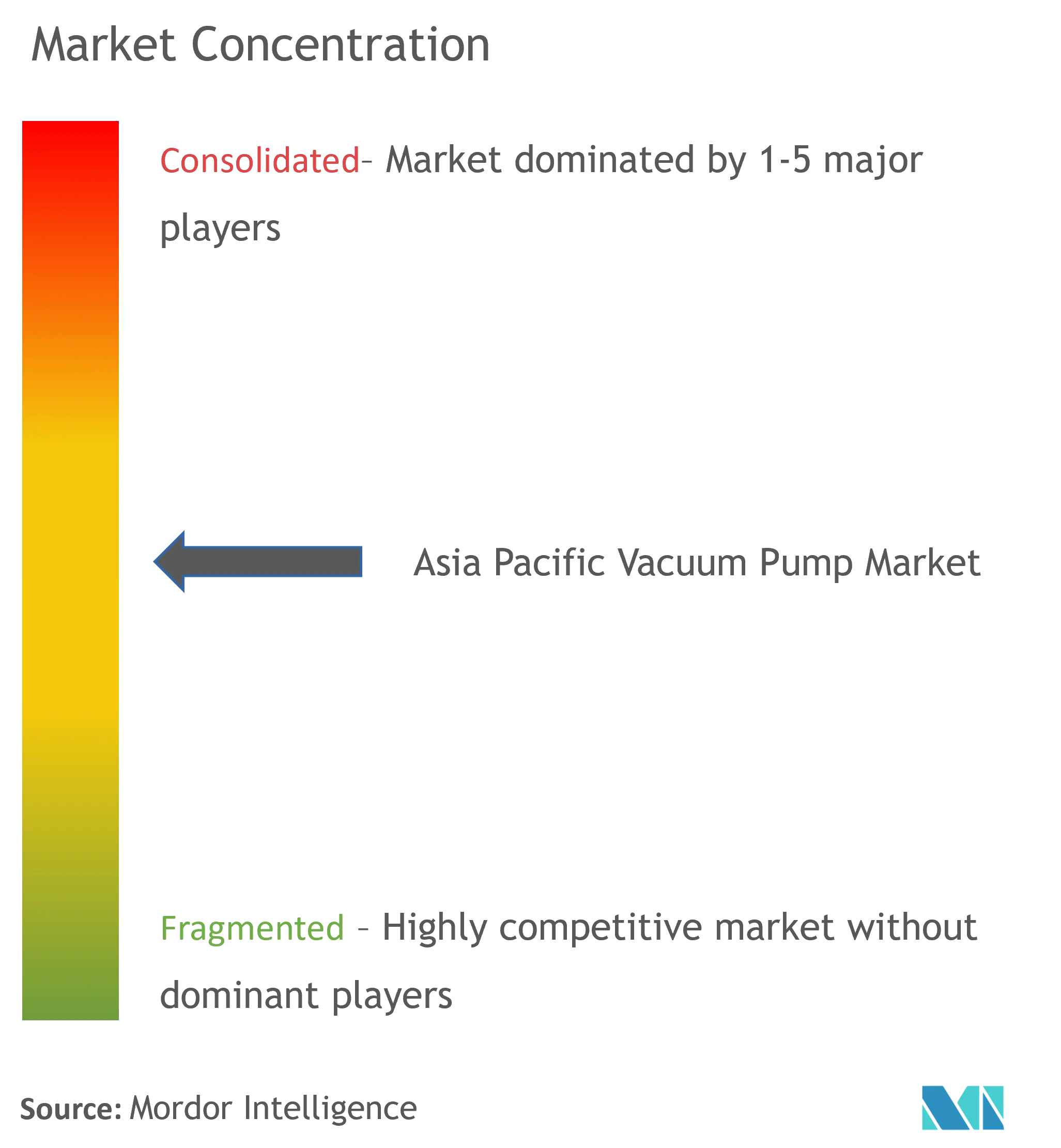
APAC Vacuum Pumps Market News
- May 2022 - Atlas Copco launched a diverse range of GHS VSD+ vacuum pumps. The new GHS 1402-2002 VSD+ series pumps feature a new design for better performance, a smaller footprint, optimal oil separation, and an innovative new controller to support the use cases of Industry 4.0. The company offers these speed-driven screw pumps in three pumping speed classes.
- January 2022 - Atlas Copco acquired HHV Pumps Pvt. Ltd., a provider of vacuum pumps for the chemical and pharmaceutical industries, electrical power equipment, and general industry, and rotary vane pumps for manufacturing refrigeration and air-conditioning.
APAC Vacuum Pumps Market Report - Table of Contents
1. INTRODUCTION
- 1.1 Study Assumption and Market Definition
- 1.2 Scope of the Study
2. RESEARCH METHODOLOGY
3. EXECUTIVE SUMMARY
4. MARKET DYNAMICS
- 4.1 Market Overview
- 4.2 Value Chain / Supply Chain Analysis
-
4.3 Industry Attractiveness - Porters Five Forces Analysis
- 4.3.1 Threat of New Entrants
- 4.3.2 Bargaining Power of Buyers
- 4.3.3 Bargaining Power of Suppliers
- 4.3.4 Threat of Substitute Products
- 4.3.5 Intensity of Competitive Rivalry
- 4.4 Impact of COVID-19 on the Market
5. MARKET DYNAMICS
-
5.1 Market Drivers
- 5.1.1 Increasing Popularity of MEMS Technology
- 5.1.2 Increasing Demand for Dry Vacuum Pump
-
5.2 Market Challenges
- 5.2.1 High Cost and Compatibility Issues
6. MARKET SEGMENTATION
-
6.1 By Type
- 6.1.1 Rotary Vacuum Pumps
- 6.1.1.1 Rotary Vane Pumps
- 6.1.1.2 Screw and Claw Pumps
- 6.1.1.3 Roots Pumps
- 6.1.2 Reciprocating Vacuum Pumps
- 6.1.2.1 Diaphragm Pumps
- 6.1.2.2 Piston Pumps
- 6.1.3 Kinetic Vacuum Pumps
- 6.1.3.1 Ejector Pumps
- 6.1.3.2 Turbomolecular Pumps
- 6.1.3.3 Diffusion Pumps
- 6.1.4 Dynamic Pumps
- 6.1.4.1 Liquid Ring Pumps
- 6.1.4.2 Side Channel Pumps
- 6.1.5 Specialized Vacuum Pumps
- 6.1.5.1 Getter Pumps
- 6.1.5.2 Cryogenic Pumps
-
6.2 By End-user Application
- 6.2.1 Oil and Gas
- 6.2.2 Electronics
- 6.2.3 Medicine
- 6.2.4 Chemical Processing
- 6.2.5 Food and Beverages
- 6.2.6 Power Generation
- 6.2.7 Other End-user Applications (Wood, Paper and Pulp, etc.)
-
6.3 By Region
- 6.3.1 China
- 6.3.2 Japan
- 6.3.3 India
- 6.3.4 South Korea
- 6.3.5 Rest of Asia Pacific
7. COMPETITIVE LANDSCAPE
-
7.1 Company Profiles
- 7.1.1 Atlas copco
- 7.1.2 Ebara Corporation
- 7.1.3 Agilent Technologies Inc.
- 7.1.4 Flowserve Corporation
- 7.1.5 Wintek Corporation
- 7.1.6 Becker Pumps Corporation
- 7.1.7 Tsurumi Manufacturing Co., Ltd
- 7.1.8 Ingersoll Rand Inc.
- 7.1.9 Robert Bosch
- 7.1.10 Continental AG
- *List Not Exhaustive
8. INVESTMENT ANALYSIS
9. FUTURE OF THE MARKET
** Subject To AvailablityAPAC Vacuum Pumps Industry Segmentation
A vacuum pump is an equipment capable of generating a partial or low-pressure vacuum by pushing gas or air molecules out of a sealed chamber. A vacuum is a relative state at which the chamber pressure has a lower pressure than the ambient atmosphere or adjacent systems. This is different from an absolute vacuum, where the pressure is at 0 Pa and devoid of gas molecules.
The Asia Pacific Vacuum Pumps Market is segmented by Type (Rotary Vacuum Pumps (Rotary Vane Pumps, Screw, and Claw Pumps, Root Pumps), Reciprocating Vacuum Pumps (Diaphragm Pumps, Piston Pumps), Kinetic Vacuum Pumps (Ejector Pumps, Turbomolecular Pumps, Diffusion Pumps), Dynamic Pumps (Liquid Ring Pumps, Side Channel Pumps), Specialized Vacuum Pumps (Getter Pumps, Cryogenic Pumps)), End-user Application (Oil and Gas, Electronics, Medicine, Chemical Processing, Food and Beverages, Power Generation), and Region.
| By Type | Rotary Vacuum Pumps | Rotary Vane Pumps |
| Screw and Claw Pumps | ||
| Roots Pumps | ||
| By Type | Reciprocating Vacuum Pumps | Diaphragm Pumps |
| Piston Pumps | ||
| By Type | Kinetic Vacuum Pumps | Ejector Pumps |
| Turbomolecular Pumps | ||
| Diffusion Pumps | ||
| By Type | Dynamic Pumps | Liquid Ring Pumps |
| Side Channel Pumps | ||
| By Type | Specialized Vacuum Pumps | Getter Pumps |
| Cryogenic Pumps | ||
| By End-user Application | Oil and Gas | |
| Electronics | ||
| Medicine | ||
| Chemical Processing | ||
| Food and Beverages | ||
| Power Generation | ||
| Other End-user Applications (Wood, Paper and Pulp, etc.) | ||
| By Region | China | |
| Japan | ||
| India | ||
| South Korea | ||
| Rest of Asia Pacific |
APAC Vacuum Pumps Market Research FAQs
What is the current Asia Pacific Vacuum Pumps Market size?
The Asia Pacific Vacuum Pumps Market is projected to register a CAGR of 8.20% during the forecast period (2024-2029)
Who are the key players in Asia Pacific Vacuum Pumps Market?
Agilent Technologies Inc., Atlas copco, Wintek Corporation, Ebara Corporation and Flowserve Corporation are the major companies operating in the Asia Pacific Vacuum Pumps Market.
What years does this Asia Pacific Vacuum Pumps Market cover?
The report covers the Asia Pacific Vacuum Pumps Market historical market size for years: 2019, 2020, 2021, 2022 and 2023. The report also forecasts the Asia Pacific Vacuum Pumps Market size for years: 2024, 2025, 2026, 2027, 2028 and 2029.
Asia Pacific Vacuum Pumps Industry Report
Statistics for the 2024 Asia Pacific Vacuum Pumps market share, size and revenue growth rate, created by Mordor Intelligence™ Industry Reports. Asia Pacific Vacuum Pumps analysis includes a market forecast outlook to 2029 and historical overview. Get a sample of this industry analysis as a free report PDF download.



